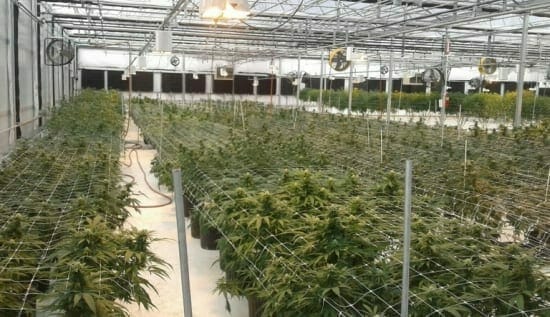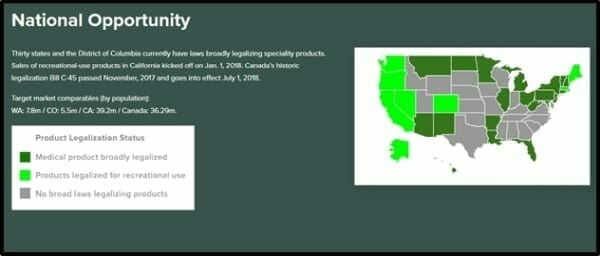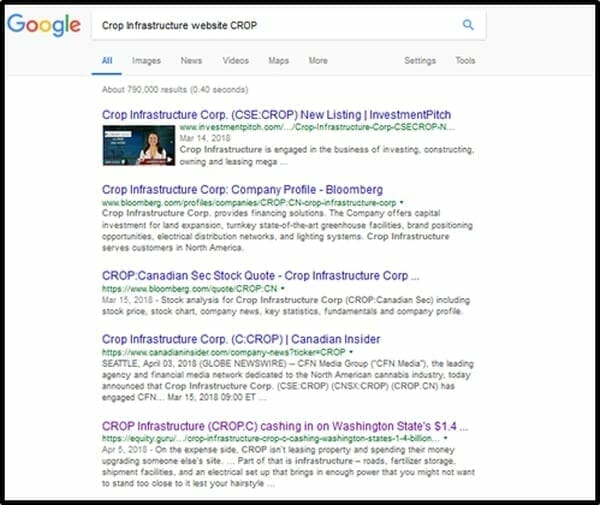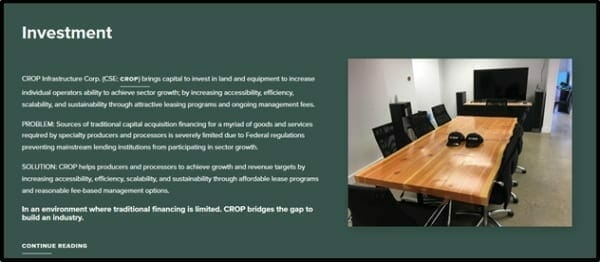Publicly traded companies are two-headed monsters: 1. legal businesses trying to achieve a commercial objective, and 2. investment vehicles for shareholders.
The second job requires skilled Investor Relations (IR) that can tell the story to everyone – fat cat, institution, and Joe Public.
Crop Infrastructure (CROP.C) isn’t hitting that task on all cylinders yet – and it’s a shame because they have an excellent business.
CROP Infrastructure Corp. (CSE: CROP) invests capital in land and equipment to increase operators sector growth; by increasing efficiency, scalability, and sustainability through attractive leasing programs and ongoing management fees.
Problem: Federal regulations prevent mainstream lending institutions from participating in weed sector growth.
Solution: CROP invests in producers and processors through lease programs and fee-based management options.
If you want to dumb down the CROP business model – think of it as weed-specific Real Estate Investment Trust (REIT).
According to Investopedia, “REITs operate, income-producing real estate – from office and apartment buildings to warehouses, hospitals, shopping centers, hotels and timberlands.”
On March 14, 2018 CROP announced that Phase one construction consisting of site preparation including foundations for twelve indoor agricultural canopies encompassing a planned total area of ~44,000 square feet is nearing completion.
The Company will shortly begin Phase 2 construction of the next group of six greenhouses, bringing another 22,000 square feet of canopy online. Total projected tenant production capacity is about 24,000 lbs.
Three weeks ago, Equity Guru principal Chris Parry weighed in the Crop Infrastructure business model, “CROP isn’t leasing property and spending their money upgrading someone else’s site. They’re purchasing real estate and owning the whole enchilada, which means they’re anchored into an asset that’s worth something.
On their revenue side, they’re charging tenants a 60% preferential payback through lease and management fees. Once their capital is deployed in full, they apply a 30% land management fee – essentially a royalty – in perpetuity.”
Growing weed on real-estate that you own is an interesting value-proposition for CROP shareholders.
The average value of U.S farm land increased 47% between 2009 and 2017, according to the 2018 U.S. Baseline Outlook compiled by Food and Agricultural Policy Research Institute.
Appreciation on commercial land becomes a store of value. If weed farmers are making bank – the appreciation accelerates.
Crop projects its tenant growers to harvest 30,645 grams every day for every fully operational 43,680 sq/ft facility.
Yes, 43,680 square feet in 12 separate self-contained state of the art greenhouses. To put that in perspective, Aurora Cannabis (ACB.T) currently grows out of 55,000 square feet.
One of the downsides of agriculture north of San Diego is that it sucks up a lot of electricity.
But CROP is building its grow facility in an area with freakishly low electricity costs.
The Washington Mega Greenhouse pays a regional electrical rate of $0.02/kWh USD. The average commercial rate in Washington is $0.08/kWh, California businesses pay 700% more: $0.15/kWh.
How big of an advantage is that for CROP?
Let’s put it this way: it’s like an ice-cream maker living next to a dairy farmer who delivers vats of double-cream for .39 a gallon. You still have to know how to make ice-cream. But the pathway to profitability just got a whole lot easier.
This REIT-like business model is scalable, CROP is already eye-balling expansions in other territories.
With think CROP has a smart business model with a ton of upside.
Now we get to the topic of Investor Relations – which is sub-standard at this point.
Weak IR is not a big problem for Equity Guru writers – because we have direct access to CEOs. We’ll often use that access to research a subplot or seek an answer to an investor’s question.
But we also like to walk down Main Street – to make sure there’s no disconnect between management talking points – and the outward face of the company.
First line of attack: go to website; we Googled “Crop Infrastructure website CROP”.
We see quotes by Bloomberg. An Equity Guru article. Scanned through 3 pages – couldn’t find the website. No biggie. We get it. SEO is snake oil. A co-worker provided the link.
Second line of attack: download the corporate presentation. Clicking on “Investment” takes you to a splash page with a photo of their boardroom table.
After about 20 more clicks (Why Crop?/How We Work/Legality/Properties/ Washington/California/About us/News) – we had manually assembled a crude overview – but still no Corporate Presentation.
Third line of attack: contact Investor Relations (IR). Clicking “Contact Us” gets you to a map of Vancouver and invitation to send an e.mail to info@cropcorp.com.
Checked the press releases. Same e.mail: info@cropcorp.com
Dear Crop Infrastructure – if the CEO is too busy to interface with retail shareholders – then appoint someone else to do it:
Example: here’s the bottom of HIKU’s last press releases:
Will Stewart
Hiku Vice President of Corporate Communications and Public Affairs
416-899-9422
wstewart@hiku.com
Keith Merker
WeedMD CFO
519-706-4900
keith@weedmd.com
See how easy that was? Two names. Two telephone numbers. Two emails.
If the CROP management team is dealing with investors who have fat pockets directly and hasn’t got their IR machine focused on Joe Retail yet, or they’re busy at the operations side – hire a 23-year-old fresh out of the SEC course. Teach him your business. Give him a personalized email address. Put him in a room with phone. Don’t worry about the dress code. He’ll already own an incongruously expensive suit. Let him talk to the retail investors. $3,000 a month and few stock options he’ll breath fire all day.
We get why an ambitious, talented CEO might be disinterested in shareholder communications. But it’s frustrating when there’s something so inherently worth communicating.
This $43 million company could end up being a monster.
Love the business. Love the pitch. Let’s get the thing firing on all cylinders.
Full Disclosure: Crop Infrastructure is an Equity Guru marketing client, and we own stock.





